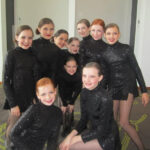Flipping through old dance revue programs offers a fascinating glimpse into the past, especially for those interested in genealogy and local history. It’s easy to imagine countless individuals echoing the fond memories of my late mother-in-law, who often reminisced about her time at Rosa Spilka’s dancing school in New Orleans during the 1940s. She spoke of her passion for dance, her continued ballet exercises, and her decision to pursue nursing instead of a dance career. This makes one wonder how many similar stories are hidden within our communities, waiting to be uncovered. Looking at these revue programs, filled with names, hints at a rich tapestry of personal narratives.
Reflecting on personal experiences, it becomes clear how many people once attended Dancing Schools. My own family history includes myself, my mother, aunt, mother-in-law, sister-in-law, husband, cousins, and niece, all having danced at some point. However, it seems fewer people engage with “dancing school” in the traditional sense today. Dance now appears more professionalized and competitive, often referred to simply as “dance.” While formal dance academies and companies have always existed for serious dancers, the widespread presence of community-based dancing schools was a defining characteristic of earlier eras, like my own tap-dancing days in the 1970s.
Community Cornerstones
Back then, it truly felt like a dancing school existed on every corner. This observation prompts deeper questions. The rapid population growth in areas like Jefferson Parish, and suburban New Orleans in general during those years, suggests a potential connection between the rise in dancing schools and community expansion.
This leads to further exploration. What else can these dancing schools reveal about a community? When did this trend begin? What were the patterns of growth? What were the demographics of these schools? How did their locations shift from urban centers to suburban and exurban areas? And what does this all say about evolving disposable incomes and societal priorities?
Significantly, many dancing schools were established and managed by women entrepreneurs. Particularly in the 1930s and 1940s, it was common for these schools to operate from the instructors’ residences, utilizing converted garages or similar spaces. By the 1960s and 1970s, a shift occurred towards dedicated, off-site studios with multiple instructors, indicating a professionalization and expansion of the industry.
Cultural Reflections in Dance
Dancing schools offer more than just nostalgic charm; they are invaluable ethnographic resources, providing insights into a community’s values, its people, and its broader culture. They serve as time capsules, reflecting social trends, economic shifts, and evolving leisure activities.
However, accessing information about these dancing schools is not straightforward. No centralized collection of materials exists. There isn’t a readily available comprehensive list, nor a dedicated archive for revue programs, photographs, or oral histories.
Much of what remains is scattered within personal collections – tucked away in closets, attics, cedar chests, boxes under beds, garages, or storage units. And this is assuming these materials haven’t been lost, discarded, or damaged over time. Business records, certifications, and related documents are likely dispersed across various specialty files or organizations.
To begin piecing together this history, city directories and old newspapers are invaluable. They can be mined to create lists of school names, locations, and basic details like the types of dance instruction offered. Genealogical research methods, particularly obituary searches, can also be incredibly effective. For many dance instructors, teaching was more than just a job; it was a passion, a significant part of their identity. As such, it’s frequently mentioned in their obituaries, offering a valuable link to their dancing school legacy.
Preserving Community Stories
To gauge broader interest in this topic, sharing a vintage photograph in a New Orleans nostalgia Facebook group generated an impressive 140 responses. Searching the group for “dancing school” reveals numerous posts filled with shared stories, photographs of revue programs, pins, awards, and personal recollections. This online engagement underscores the enduring appeal and community connection associated with dancing schools.
Yet, social media platforms like Facebook are not archives. There’s no curator to organize and categorize this wealth of information, nor to ensure adherence to privacy and copyright regulations. This shared history, valuable as it is, could vanish with a server change or platform update.
The information is out there, and the public interest is evident. These stories and records deserve preservation. Initiatives to collect and archive these materials are crucial. Perhaps, in the future, a dedicated resource will exist where individuals can explore this unique aspect of community history, its people, and its cultural heritage, all through the lens of dancing schools.

